Get PeakVisor App
Sign In
Search by GPS coordinates
- Latitude
- ° ' ''
- Longitude
- ° ' ''
- Units of Length

Yes
Cancel
Share ×

Scan the QR code and open PeakVisor on your phone
❤ Wishlist ×
Choose
Delete
Gunung Leuser National Park, located on the island of Sumatra, is one of Indonesia’s 55 national parks. Historically, the park spanned over 8,000 square kilometers (3,088 sq. mi) of rugged rainforest—though today, rampant deforestation is degrading tree cover throughout the park. Gunung Leuser is best known for its biodiversity. It is one of just two remaining habitats for the critically endangered Sumatran orangutan (Pongo abelii) and hosts other rare and endangered species. Gunung Leuser National Park has 174 named mountains; the highest and most prominent is Gunung Leuser (3,466 m / 11,371 ft).
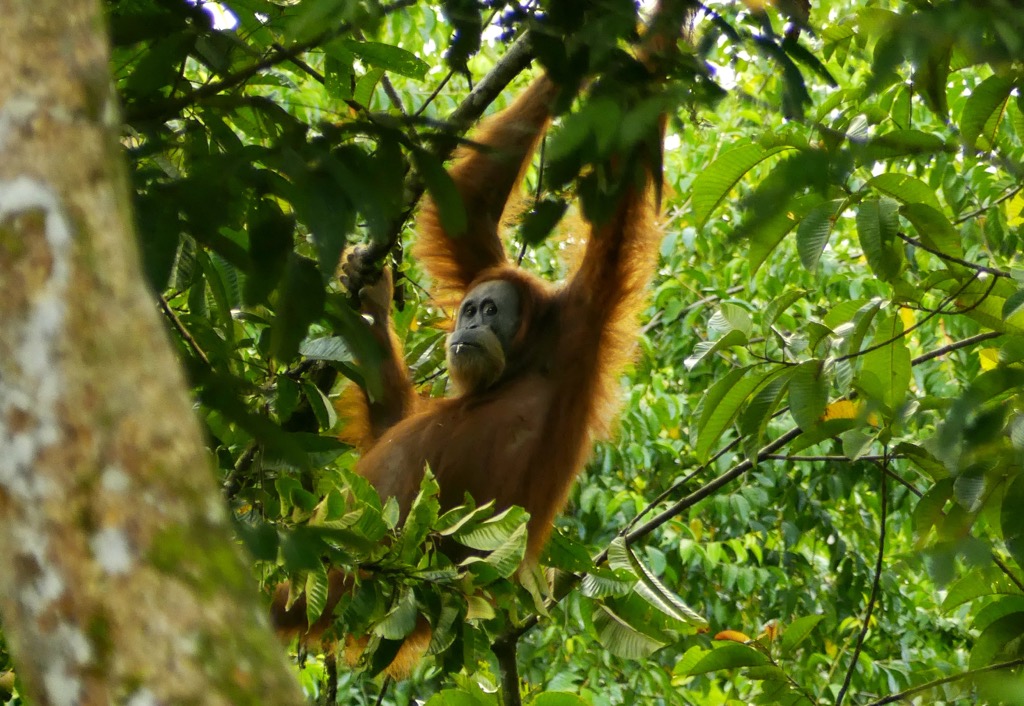
Gunung Leuser sits on the border of the provinces Aceh and North Sumatra, in the northwest of the Indonesian island of Sumatra. Sumatra is the world’s sixth-largest island and the second-largest island in Indonesia after Borneo / Kalimantan. Along with neighboring national parks Bukit Barisan Selatan and Kerinci Seblat, Gunung Leuser forms the “Tropical Rainforest Heritage of Sumatra” UNESCO World Heritage Site.
Gunung Leuser is highly mountainous; Gunung means “mountain” in Indonesian. Around 40% of the park’s land area, predominantly in the northwest, is over 1,500 meters (4,931 ft) elevation. The park’s most significant geographic feature is the Bukit Barisan range, which contains 35 active volcanic summits, including the park’s high point, Gunung Leuser (3,466 m / 11,371 ft). This range runs northwest-southeast along the spine of Sumatra.

In the park's lower elevations, the landscape changes from subalpine low forest to a mosaic of rich lowland and montane rainforests and jungles. These verdant forests are a haven for biodiversity, harboring an astonishing array of plant and animal species. Towering dipterocarp trees, with their massive trunks and broad canopies, reign over the landscape, while a rich undergrowth of ferns, orchids, and other exotic plants thrives in the humid environment. Humidity levels in the park are consistently high, often reaching 80% or more.
Numerous rivers and streams snake through Gunung Leuser, their waters sourced from the mountains and rainforests. The Alas River, one of the largest rivers in Sumatra, cuts through the park and is a popular destination for whitewater rafting and kayaking.
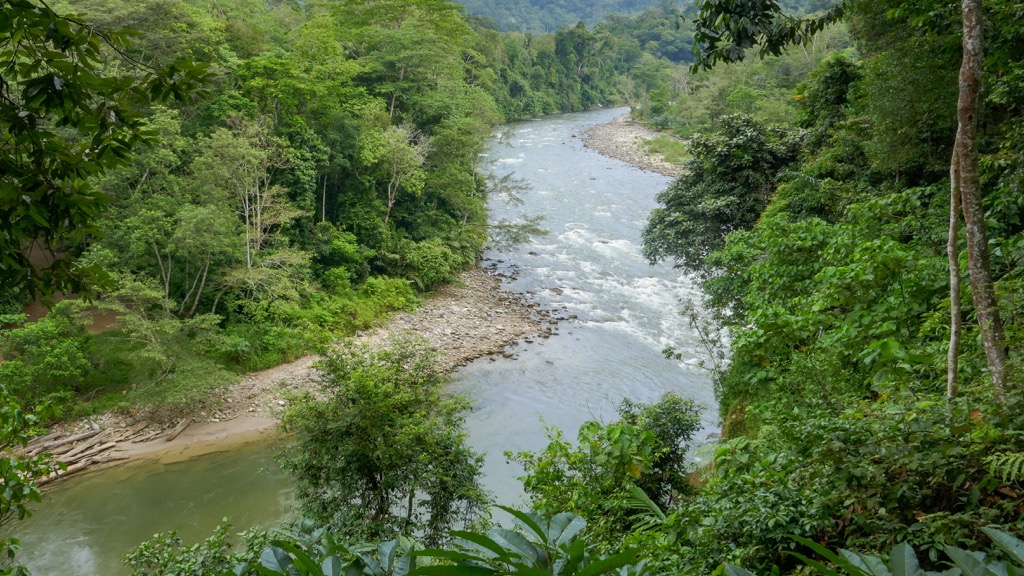
The average temperature in the park ranges from 21°C to 28°C (70°F to 82°F) in the lowlands and decreases with elevation in the mountainous areas. At higher altitudes, temperatures can drop to 10°C or 15°C (50°F to 59°F), or even lower. The park's diverse topography creates microclimates, with variations in temperature and rainfall depending on elevation and exposure to sunlight and wind.
However, the park receives a high amount of rainfall on average, averaging 3,000 to 4,000 millimeters (118 to 157 inches) annually. Rainfall is distributed relatively evenly throughout the year, although there are drier periods from June to August and January to February. However, even during these periods, rain showers are frequent.
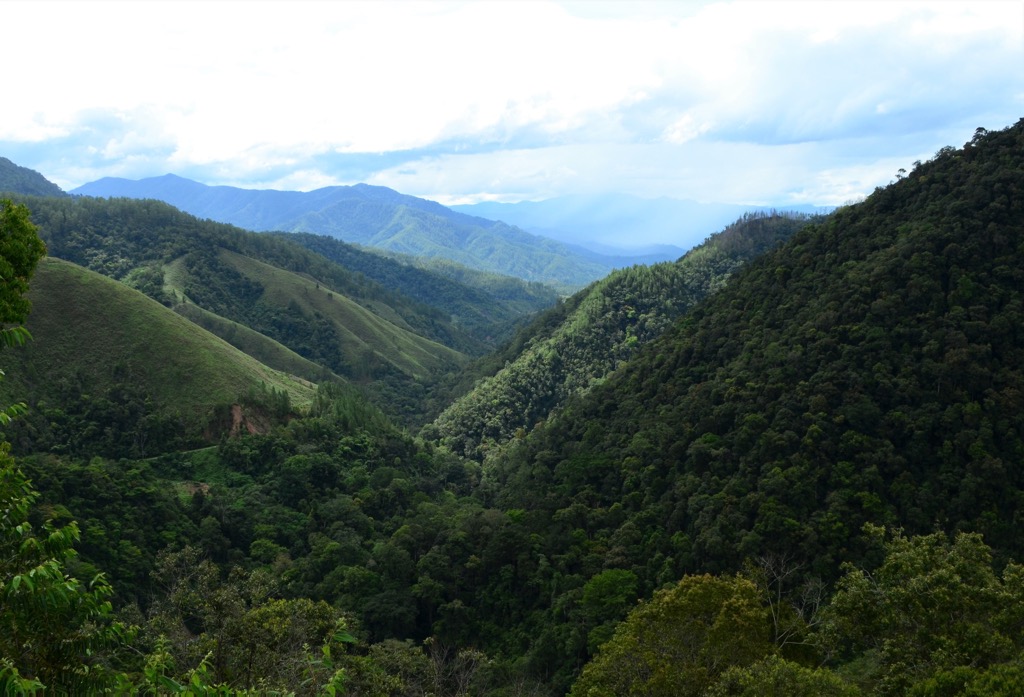
The Gunung Leuser region is dominated by the Bukit Barisan mountain range, a volcanic arc that stretches for nearly 1,700 kilometers (1,056 mi) along Sumatra’s western edge. The Bukit Barisan range owes its existence to the complex interactions between the Indo-Australian and Sunda tectonic plates.
For over 100 million years, the Indo-Australian Plate has been subducting beneath the smaller Sunda Plate along the Java Trench, a deep-sea trench located off Sumatra's southwestern coast. This subduction process generates intense heat and pressure, leading to the melting of mantle material and the creation of magma. As the magma rises through the overlying crust, it fuels volcanic activity throughout the boundary, cultivating a string of volcanoes known as the “Sunda Arc,” including the Bukit Barisan range of Sumatra and the high point Gunung Leuser (3,466 m / 11,371 ft) peak.
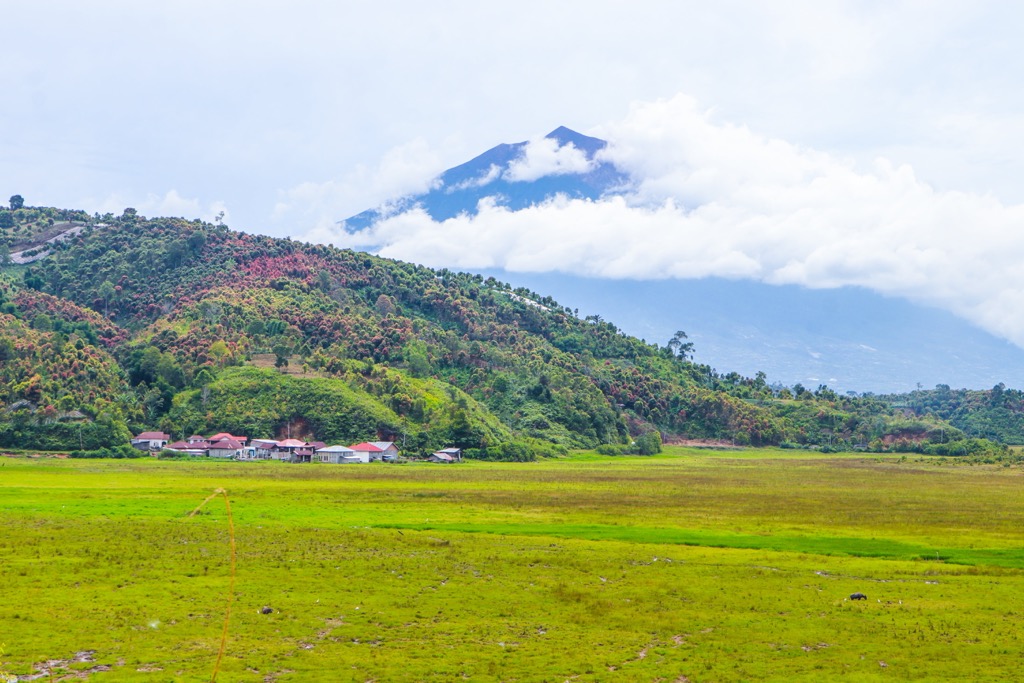
The volcanic history of the Bukit Barisan is punctuated by periods of intense activity and relative quiescence. The range's volcanoes are primarily andesitic to dacitic in composition, reflecting the partial melting of subducted oceanic crust and overlying mantle material. Volcanic products include lava flows, pyroclastic deposits, and volcaniclastic sediments.
Over millions of years, volcanic eruptions have shaped and reshaped the landscape. The formation of stratovolcanoes, such as Gunung Sinabung (2,460 m / 8,071 ft) and Gunung Sibayak (2,212 m / 7,257 ft), is a testament to the repeated accumulation of volcanic material.
Calderas, large volcanic depressions formed by the collapse of magma chambers, are also present in the region. The most famous is Lake Toba, the largest volcanic lake in the world, formed during a supervolcanic eruption approximately 74,000 years ago. Toba’s is the largest (known) explosive eruption on Earth in the last 25 million years, and some scientists believe the eruption was so massive that it killed almost all human beings living on Earth at the time. Although not within the park, Lake Toba is just 133 km (82.7 mi) to the southeast and spans 1,140 square kilometers (440 sq. mi).
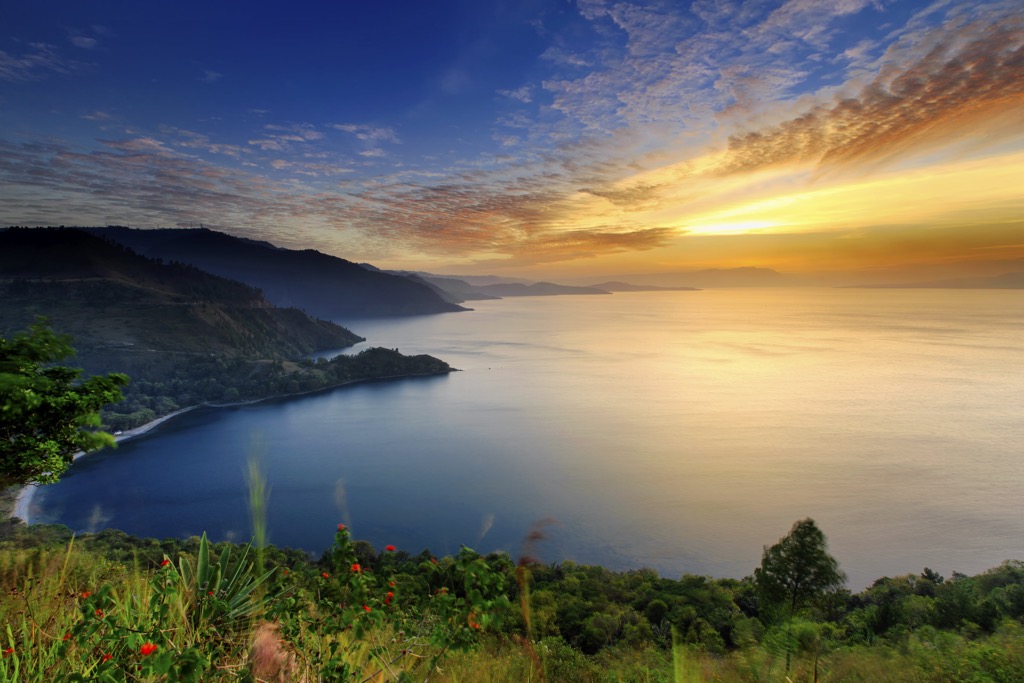
While the Bukit Barisan range's volcanic activity has played a crucial role in shaping the region's geology, it also poses significant geologic hazards. Volcanic eruptions, earthquakes, and landslides are all potential risks associated with the landscape. Devastating earthquakes and tsunamis in 2004 and 2006 are prime examples. The 2004 tsunami is the deadliest in history, killing an estimated 227,000 people in 14 counrties.
The stratovolcano Sinabung, in particular, has proven volatile and dangerous. It has erupted dozens of times since reactivating in 2010 (following a 400-year hiatus). Around 30 people have been killed as a result of the peak’s activity. It most recently experienced a significant eruption in July 2021, when a column of smoke and ash shot 4,500 meters (14,760 ft) into the sky. Lava flows also traveled for over 1000 meters (3,300 ft) down its slopes as a result of this eruption.
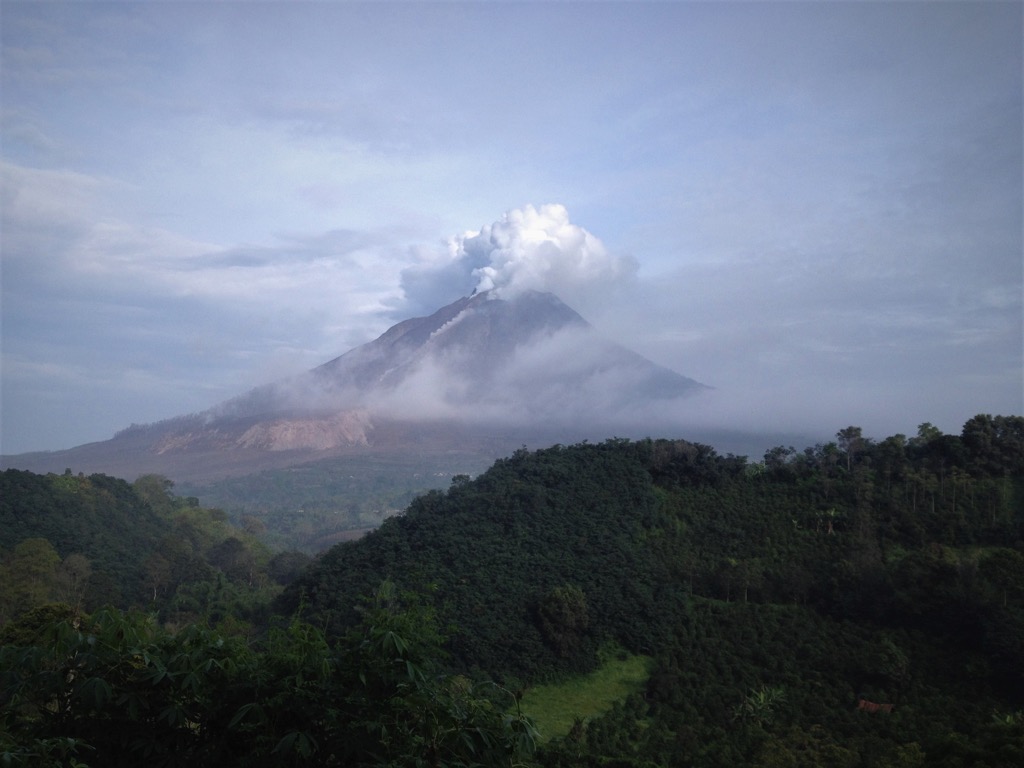
Gunung Leuser is best known for its staggering biodiversity. The park has an estimated 10,000 different plant species, nearly 600 bird species, 200 mammal species, and almost 100 species of amphibians and reptiles. Many of these endemic species, such as the Sumatran orangutan (Pongo abelii), rhino (Dicerorhinus sumatrensis), elephant (Elephas maximus sumatrensis), and Sumatra tiger (Panthera tigris sondaica), are extremely rare and critically endangered.
Gunung Leuser is the only place left on Earth where tigers, elephants, orangutans, and rhinos live together in the wild. While all of these species have shockingly low numbers due to poaching and habitat loss, the Sumatran rhino, in particular, is on the verge of total extinction. Less than 50 remain alive in the wild.

Other notable species of fauna include the Malaysian sun bear (Helarctos malayanus), spiny terrapin turtles (Heosemys spinosa), several species of hornbill, king cobra (Ophiophagus hannah), and slow loris (Nycticebus coucang). Besides the orangutans, smaller primates like siamang gibbons (Symphalangus syndactylus), long-tailed macaques (Macaca fascicularis), Thomas’s Langur (Presbytis thomasi), silver-leafed monkeys (Trachypithecus cristatus) are widespread.
NOTE: This author spent some weeks in the Gunung Leuser region in early 2024 and was able to see many of these species in the wild (and work to conserve them) through the local nonprofit Batu Kapal Conservation.
Among the most iconic and notable plant species found in Gunung Leuser is the Rafflesia arnoldii, also known as the corpse lily or “kerubut” in Sumatra. This parasitic plant produces the largest individual flower on Earth, reaching up to a meter (3.3 ft) in diameter. Its pungent odor of rotting flesh attracts carrion flies for pollination. Another remarkable species is the Amorphophallus titanum, or titan arum, renowned for its enormous inflorescence, which can grow over 10 feet tall. Like the Rafflesia, it emits a foul odor to attract pollinators, and is similarly known as the Corpse flower.
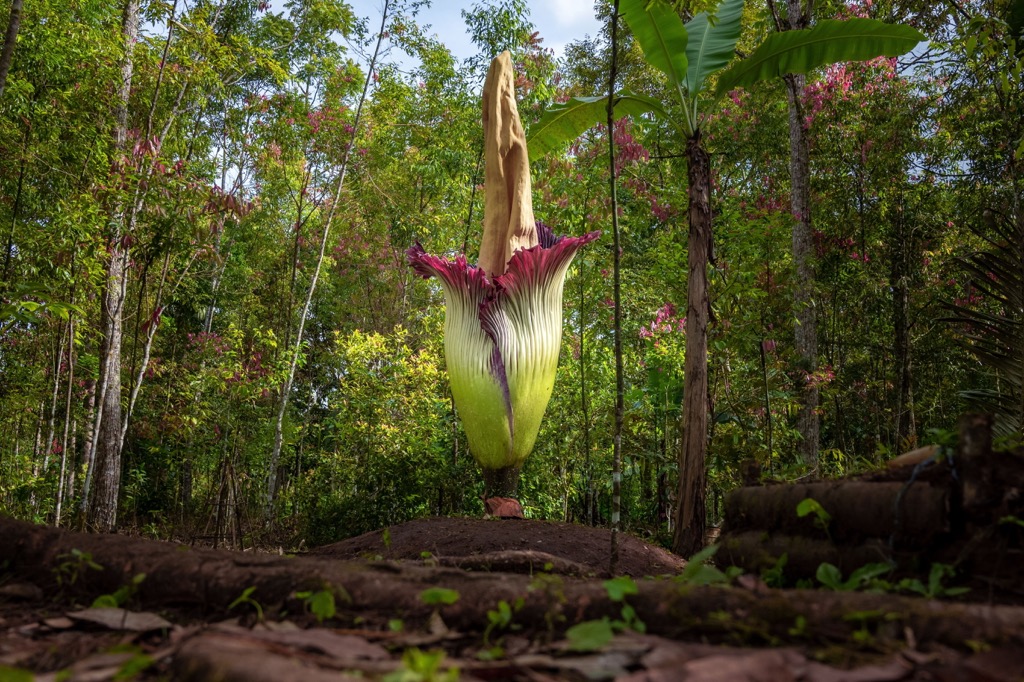
Gunung Leuser National Park’s diverse forests are home to many tree species, including dipterocarps (Dipterocarpaceae), which dominate the lowland rainforests. These towering giants provide essential habitat and food sources for countless organisms. Other notable trees include the camphor tree (Dryobalanops aromatica), valued for its aromatic resin, and various species of fig trees (Ficus spp.), which are feeding grounds for orangutans when in flower and play crucial roles in the forest ecosystem.
The understory of Gunung Leuser's forests is equally diverse, with a profusion of ferns, orchids, and other herbaceous plants. The park is particularly renowned for its orchid diversity, with hundreds of species within its boundaries. Some of the most sought-after orchids include slipper orchids (Paphiopedilum superbiens) and varieties of Dendrobium.
At higher elevations, the vegetation transitions to montane and subalpine forests, characterized by smaller trees, shrubs, and various mosses and lichens. Here, one can find unique species adapted to the cooler temperatures and harsher conditions, such as Rhododendron, blueberries, and many types of ferns and orchids.

The earliest evidence of human presence in the Gunung Leuser ecosystem dates back to the Pleistocene epoch, with archaeological findings indicating that hunter-gatherer societies inhabited the region as early as 12,000 years ago.
These early inhabitants likely relied on the forest's abundant resources for sustenance, utilizing their knowledge of the environment to hunt game, gather wild plants, and navigate the challenging terrain. The descendants of these indigenous communities, such as the Alas and Gayo peoples, still utilize a rich understanding of plant and animal life for medicinal, culinary, and spiritual purposes today.
The Gunung Leuser region also witnessed the rise and fall of several kingdoms and sultanates, each leaving its mark on the region's history and culture. The most notable was the Aceh Sultanate, which emerged in the late 15th century and exerted significant influence over Sumatra and the surrounding region.
The Aceh Sultanate played a crucial role in developing trade and commerce in the region, facilitating the exchange of goods such as spices, textiles, and precious metals. During the early 1800s, the kingdom produced over half the world's supply of pepper. It also fostered a vibrant intellectual and artistic culture, patronizing scholars, poets, and artists.
The Aceh Sultanate was dominant in the Strait of Malacca for centuries, vying with—among other regional powers—the Sultanate of Johor and Portuguese-controlled Malacca, but experienced decline and eventual fall to the Dutch Empire in the bloody Aceh or ‘Infidel’ War (1873–1904).
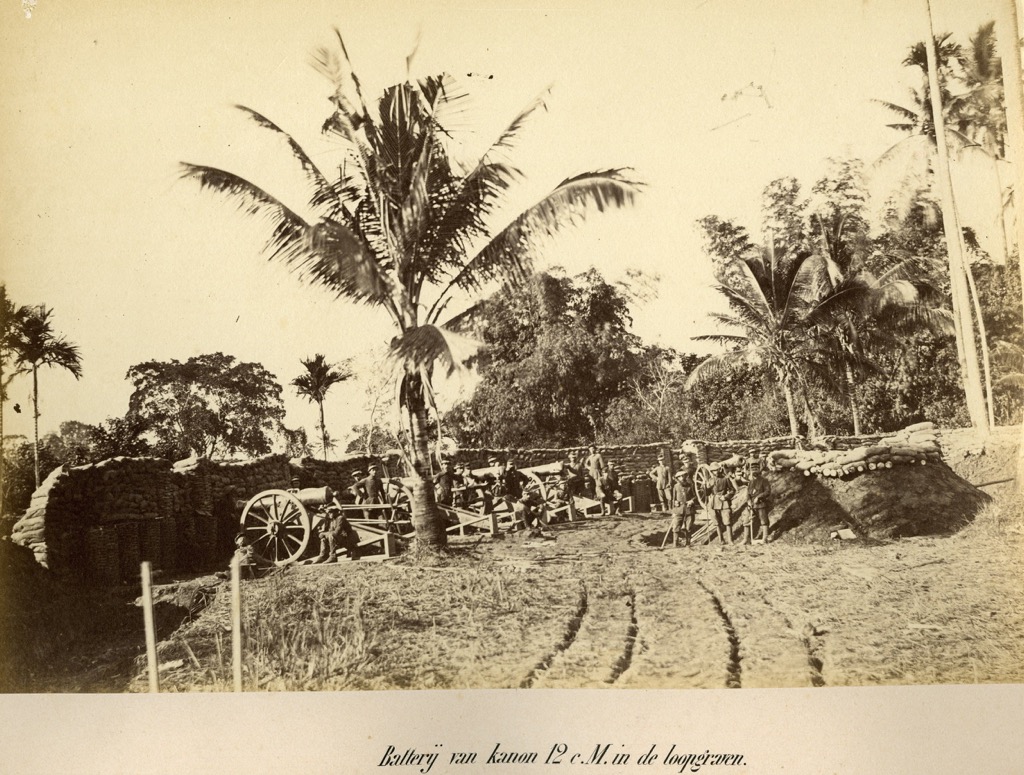
The Dutch colonial period witnessed a significant increase in the exploitation of the Gunung Leuser ecosystem's natural resources. Large-scale logging operations commenced, clearing vast swathes of forest for timber extraction. Plantations were established to cultivate cash crops such as rubber and coffee, further transforming the landscape. This period also saw the displacement of indigenous communities, as their traditional lands were appropriated for colonial enterprises. Many communities were forced to relocate, disrupting their livelihoods and cultural practices.
Following Indonesia's independence post-WWII (1945), the Gunung Leuser ecosystem faced new challenges as the nation began to slowly industrialize. The government established the Gunung Leuser National Park in 1980, making it one of Indonesia’s first national parks. The park, along with Bukit Barisan Selatan National Park and Kerinci Seblat National Park, was incorporated into the “Tropical Rainforest Heritage of Sumatra” UNESCO World Heritage Site in 2004.
However, despite conservation efforts, the Gunung Leuser ecosystem continues to face intense threats from illegal logging, poaching, and encroachment. Unfortunately, national park boundaries are quite porous and poorly respected. Slash-and-burn tactics to develop ever-expanding palm oil plantations and other agricultural activities have contributed to significant deforestation and habitat loss.
Per UNESCO: Threats to the integrity of the property include road development plans and agricultural encroachment. The main fundamental threatening processes are directly linked to the access provided by roads and the failure to effectively enforce existing laws. Road access facilitates illegal logging, encroachment, and poaching, which all pose significant threats to the integrity of the component parks of the property.

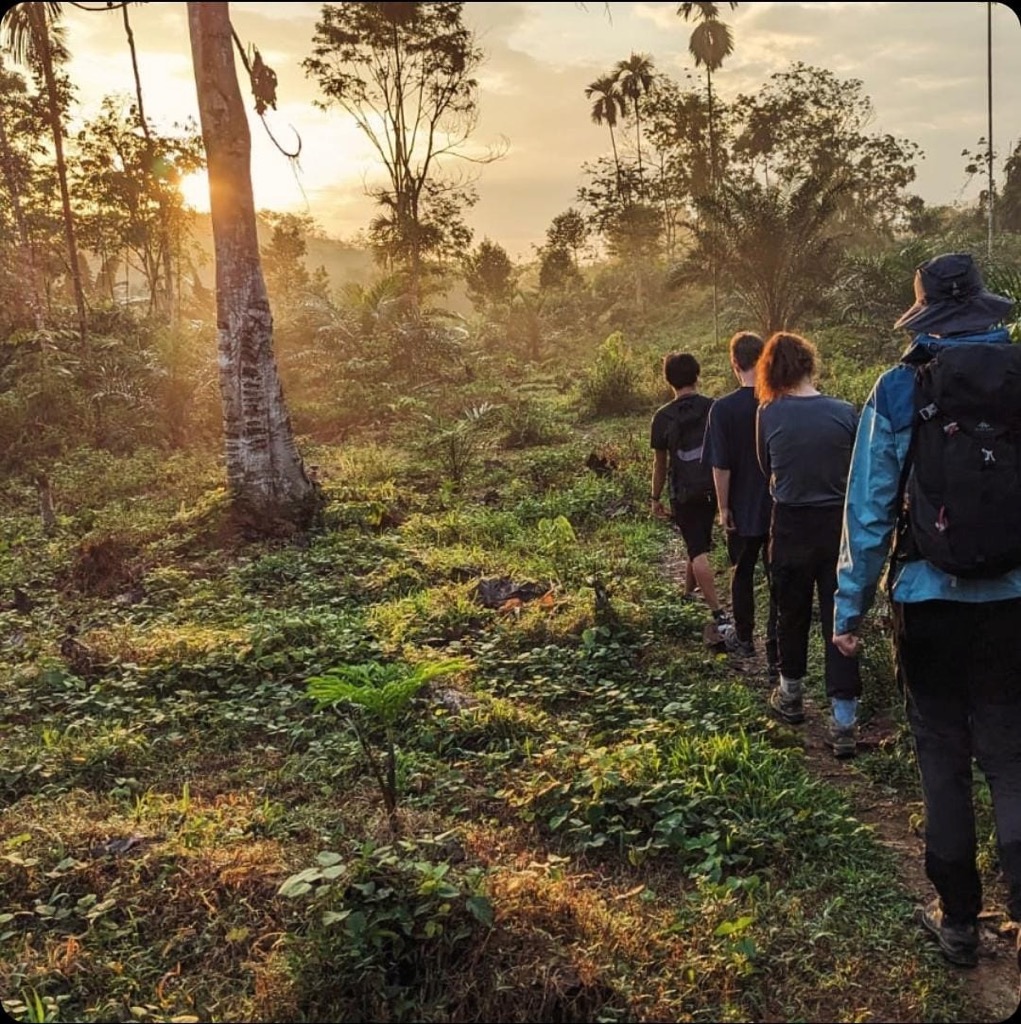
A hike to the top of stratovolcano Gunung Sibayak (2,212 m / 7,257 ft) near Berastagi is an easy but fulfilling objective for Gunung Leuser National Park visitors. The trail is a mere 2.3 kilometers (1.4 mi) out and back and entails 174 meters (570 ft) of elevation gain. Using a scooter or motorbike is recommended to reach the trailhead (3.236227 98.497022), as the upper portion of the access road is quite rough.
For a burlier objective, try Gunung Sinabung (2,460 m / 8,071 ft) near Karo. The peak is accessible via a seven-kilometer (4.3 mi) out-and-back trail that climbs around 950 meters (3,136 ft).
NOTE: Sinabung is an active volcano often closed off due to volcanic activity. This can change month to month and even week to week. Contact local guides to learn more.
You can walk around five kilometers (3.1 mi) along the Landak River in the jungle town of Bukit Lawang, crossing back and forth via rope bridges or renting an inner tube to ride downstream from locals. Don’t miss a beer at the popular “Ecolodge Bukit Lawang” and check out the bat cave just south of here, through the palm oil plantation. Watch for long-tailed macaques and even the occasional orangutan in the trees.

Nestled on the southeastern reaches of Gunung Leuser, Bukit Lawang is perhaps the most accessible tourist destination near Gunung Leuser National Park, but it’s by no means an overcrowded hub. Bukit Lawang is the starting point for most treks into the national park and also offers tubing and whitewater rafting. A few caves are in the region, one behind the Ecolodge and the other on the property of Batu Kapal (below), where you can see swarms of diadem leaf-nosed bats (Hipposideros diadema). Don’t miss the town’s market day, which runs from early morning until around 4:00 p.m. on Fridays.
The most popular activity in Bukit Lawang is viewing the critically endangered Sumatran orangutans in their natural habitat.
Unfortunately, many of the outfitters in town operate unethically, using artificial feeding platforms to turn the orangutans “semi-wild” and habituate them to human interaction. Not only does this make it harder for the orangutans to live independently in the wild, but it also instills dangerous behavioral patterns, as the apes learn to expect food from humans and may approach or harass humans.
There are plenty of ethical orangutan trekking organizations, however, that focus on trekking into the jungle to observe truly wild orangutans from afar in their natural habitat. Some also actively work to conserve this uniquely intelligent species.
This author can vouch for Batu Kapal Conservation, which offers both traditional bungalow-style lodging and communal lodging. Batu Kapal works to protect the natural environment at Gunung Leuser’s borders and conserve the endangered orangutan, as well as other rare and threatened endemic species.
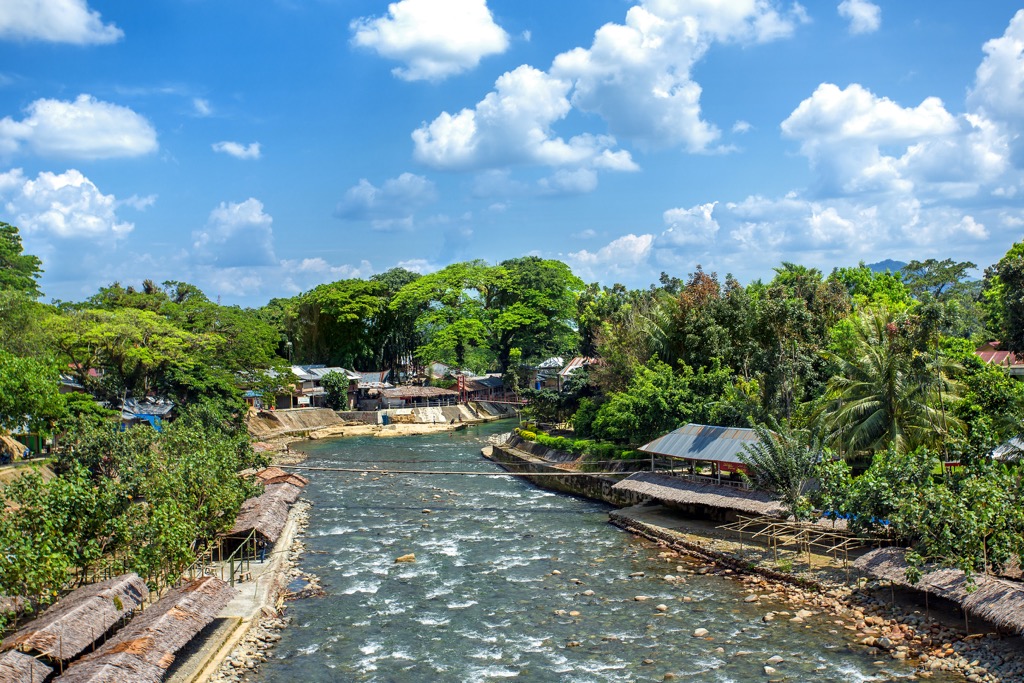
Medan (pop. 2.5 million) is the capital of North Sumatra and the largest city on the island. It is also home to an international airport, making it the destination most visitors will fly to when heading to Gunung Leuser National Park. City sights Maimun Palace, a stunning example of Malay, Islamic, and European architectural styles. Don’t miss the Tjong A Fie Mansion, either. This 35-room residence offers a glimpse into the life of a prominent eponymous Chinese-Indonesian figure.
For architecture enthusiasts, the Grand Mosque of Medan, a 1909 masterpiece blending Indian, Spanish, and Middle Eastern designs, is a must-visit. The Marian Shrine of Annai Velangkanni, a beautiful Catholic church adorned with colorful mosaics and sculptures, reflects the city's religious diversity, unique in Indonesia for its strong Christian influence.
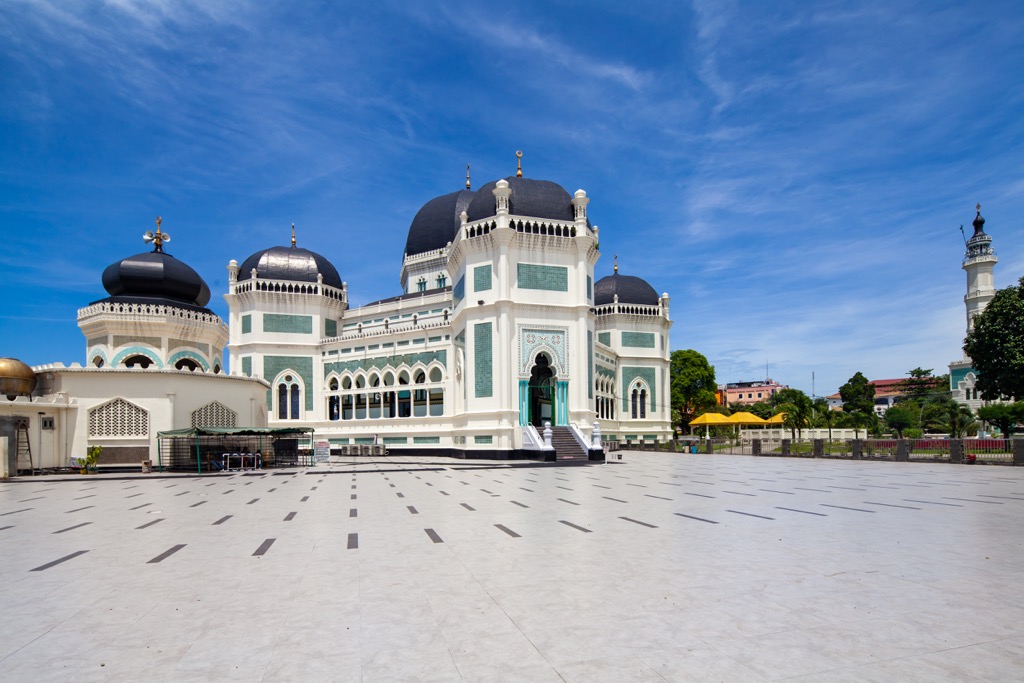
Medan's culinary scene is also worthwhile. Indulge in the diverse flavors of local cuisine, savoring iconic dishes like Soto Ayam Medan, a fragrant soup bursting with spices, or Mie Gomak, a flavorful noodle dish unique to the region. Be sure to explore Merdeka Walk, a vibrant pedestrian street lined with food stalls and restaurants offering a wide array of local and international delicacies.
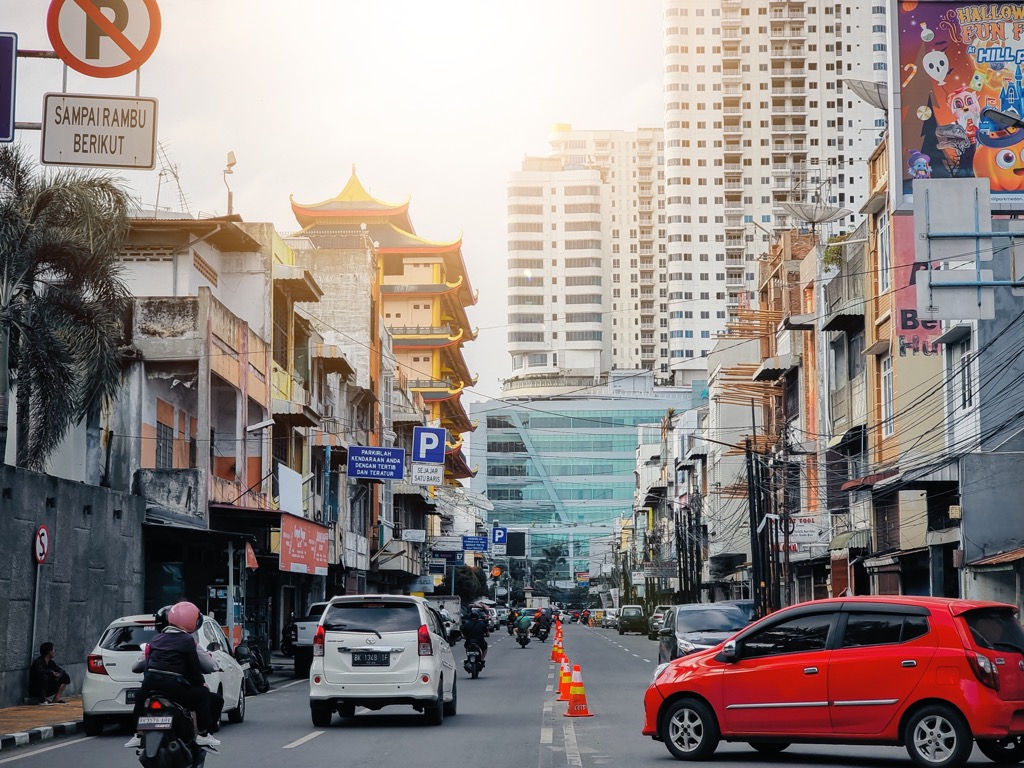
Explore Gunung Leuser National Park with the PeakVisor 3D Map and identify its summits.








